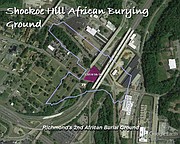Historic site review slows rail lines planned over historic Black cemetery
Jeremy M. Lazarus | 4/22/2021, 6 p.m.
Could a long-hidden Black cemetery impact plans to improve rail service between Richmond’s Main Street Station and Union Station in Washington, D.C.?
After years of trying to ignore the issue, the Federal Railroad Administration is finally paying attention.
The FRA just notified the state and the leading advocate for the cemetery, Lenora McQueen, that it will reopen its Section 106 historic site review in seeking to determine the effect the high-speed rail service may have on the historic burial ground at 5th and Hospital streets.
The move comes as planning and development continues for creating high-speed rail service between the state capital and the nation’s capital.
The cemetery originally was called the Grave Yard for Free People of Color and for Slaves. Now known as the Shockoe Hill African Burying Ground, the city-owned cemetery operated from 1816 to 1879 and is believed to be the final resting place of 22,000 Black people. It was the second burial ground the city created for free and enslaved residents.
Originally 2 acres, the cemetery grew down the hill at the site, and pillars for Interstate 64 and the current railroad tracks that were first laid around 1900 run through it, according to Ms. McQueen’s research.
The FRA review could lead to changes in the proposals to improve the current tracks and to lay new tracks.
The FRA announced the step Friday, just ahead of a City Hall announcement Monday that a 1.2-acre portion of the cemetery is back under city ownership after decades as home to a privately owned vehicle repair shop.
Mayor Levar M. Stoney stated that with City Council support, the administration shifted $145,000 internally to purchase 1305 N. 5th St., which he described as the “known portion of the cemetery.” A highway billboard and the long-vacant vehicle repair shop are now on the property.
The city’s purchase comprises 1.2 acres of the original cemetery, 1 acre of which was for free people and the other acre for enslaved dead.
Ms. McQueen, who believes several of her relatives are buried in the cemetery, has uncovered old city maps that show the location and additional land that was devoted to the cemetery over time.
In 1960, the city sold the property to the Sun Oil Co. with no acknowledgement of the cemetery. Mayor Stoney said the city plans to begin researching and properly commemorating the site.
Meanwhile, Ms. McQueen stated Friday in an email to the Free Press that she had been notified of the FRA’s decision. She stated that the FRA was taking the action after receiving notice from the Virginia Department of Historic Resources of the pending effort to add the Shockoe Hill Burying Ground Historic District to the state and federal registers of historic places.
The proposed historic district would include the Shockoe Hill African Burying Ground that lies on the northeast side of 5th and Hospital streets, along with the city’s Shockoe Hill Cemetery and the Hebrew Cemetery and other historic sites. Ms. Queen and local historians have spearheaded the creation of the district.
The FRA action is the latest triumph for Ms. McQueen, a Texas woman whose persistent lobbying over two years pushed the city to reacquire part of the cemetery and recognize it.
She stated the FRA also invited her to become “an officially recognized Section 106 consulting party.” Section 106 refers to a section of the federal historic preservation law that spells out the duties of federal agencies to identify, protect and prevent damage to historic sites in pursuing development.
“It is my sincere hope and request that the Shockoe Hill African Burying Ground will be given the care, honor, respect, recognition and protection that it so desperately deserves,” Ms. McQueen stated. The burial ground “has suffered so greatly and for so long. It deserves to be known, to be seen openly, honestly and in its entirety.”








